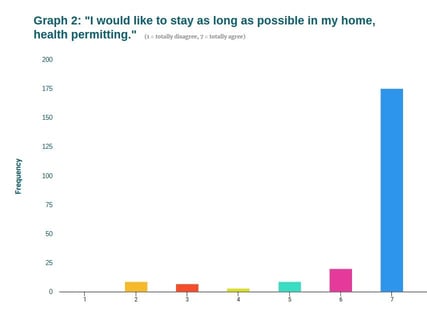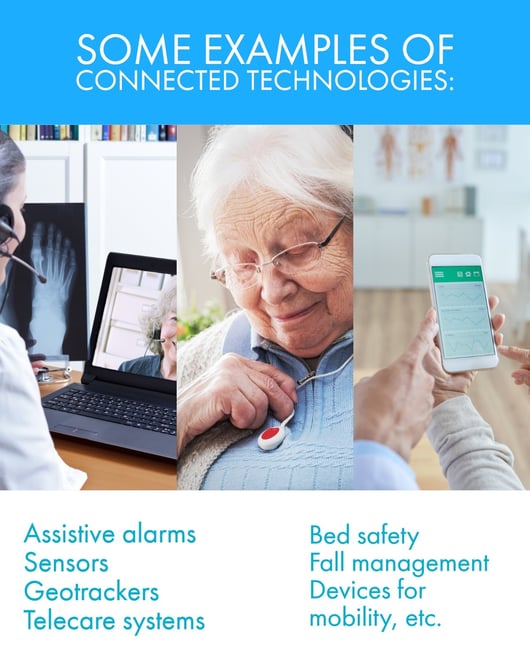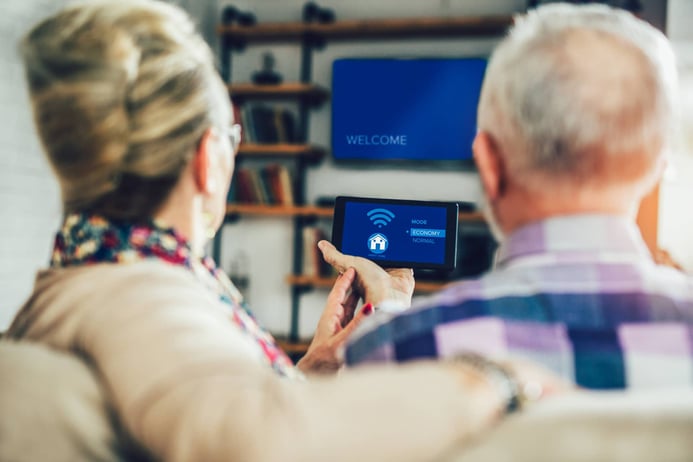As life expectancy continues to increase in our ageing populations, improving the quality of life for the elderly presents a major challenge for today’s society.
The number of elderly people going into residential care in Switzerland is expected to grow exponentially over the next 20 to 40 years (see graph 1).

At École hôtelière de Lausanne, we have been exploring the issue of seniors and the quality of life at home. The research consisted of two studies:
- one focusing on health and connected technologies;
- the other on the perceived quality of care at home.
We conducted a series of interviews with local and regional health actors, as well as a questionnaire with some 213 respondents who are clients of organizations such as the Red Cross (Neuchâtel), Asema, and Domosafety.
Seniors’ smart homes are houses or apartments equipped with technology to enhance the safety of elderly people at home and monitor their health. As people are living longer nowadays, seniors increasingly require care and so new healthcare technologies may be able to help improve their quality of life at home.
From our research it was clear that seniors wish to remain independent and stay at home as long as possible – health permitting – rather than going into nursing homes (see graph 2).

With the emergence of new technologies to monitor health and enhance safety, they may feel more safe and secure in their homes as they are able to raise the alarm quickly if they have a fall or need assistance. Several technologies are also sufficiently ‘smart’ to raise the alarm automatically when they identify a problem.
How can the hospitality industry help senior homes?
As an industry, we have to rethink the way in which services are provided to the elderly. With seniors wanting to stay at home as long as possible instead of going into nursing homes, continuing home care is becoming a pressing objective and connected technologies can revolutionize these kinds of services (see examples in box below).
Hospitality is not just about hotels, it also encompasses residential and nursing homes and, by extension, can be involved in developing and delivering new technologies for seniors’ smart homes.
In essence, we can expand the range of industries which come under the ‘hospitality’ umbrella. Moreover, home care service companies should also revisit the definition of ‘service’ and identify whether these connected technologies can improve the quality of life of our seniors or not.
For our research, we adapted a tool called SERVQUAL (Parasuraman et al., 1988), a research tool designed to measure consumer perceptions of five dimensions of service quality:
- Reliability (the ability to perform dependably and precisely);
- Assurance (the ability to inspire confidence);
- Responsiveness (the ability to provide prompt service);
- Empathy (customized attention for individual users); and
- Tangibles (physical facilities, equipment).

Barriers to better usage of connected health technologies
From the interviews we conducted for our research, we found several factors pose obstacles to improved connected health technologies or ‘teleassistance’ devices:
- Caregivers show a lack of enthusiasm for, and knowledge of, new technologies
- Financial issues and a lack of government participation (for example, teleassistance is not covered by Swiss health insurance law, LaMal)
- A lack of centralized data and coordination between different partners (food and health service providers, teleassistance, occupational therapists, etc.)
- Ethical issues. (Where will the data will be stored? Who will have access to it, etc.?)
Some recommendations and challenges for home care service companies
We believe it’s time to rethink the way services are provided to the elderly. We have made recommendations – and highlighted some challenges – for home care service companies based on feedback from clients in our study:
- Keep the same hours for visits - [“Lack of precise time of visits”, “Deliver services at a fixed and regular time", "Come on time", "Keep me informed about the time of visits.”]
- Retain the same employees (if possible) - ["I'd like to always have the same person", "No change of people”, "Have only two people taking care of me."]
- Improve communications between the service company and clients, family members and other home care providers
- Enhance socialization - ["Bring me out with my scooter", "Give me more mobility", "A person to eat with", "Break with loneliness".]
- Make clients feel more safe and secure through connected technologies -[“Will the alarm really work when I will need it? 24 hours a day?” (Possible solution: test the alarm at least once a month)]
- Increase socialization between neighbors in case of an emergency
Our results also show:
- The more advanced in age seniors are, the more they judge that connected technologies positively impact their connection with the outside world.
- Male seniors find connected technologies more intrusive than their female counterparts.
- Seniors who live alone are more willing to accept the use of these technologies, compared to those who live with their spouse.
- A majority of home care service companies fail to integrate connected technologies with their services.
In conclusion
The hospitality industry and École hôtelière de Lausanne as a leading hospitality institution have a role to play in the provision of services to seniors. The challenge will be to bring hospitality into seniors’ homes by adapting best practices (empathy, responsiveness, reliability, assurance, communication, etc.) and developing technologies to meet the specific needs of our seniors.
"Technological innovation" can only be successful if it’s in tandem with "social innovation".
Full Professor at EHL Hospitality Business School




